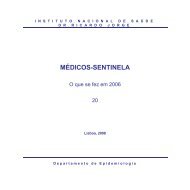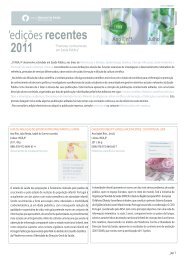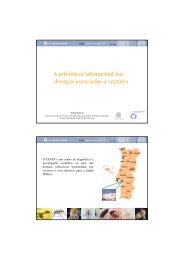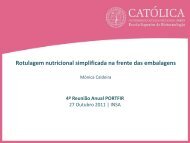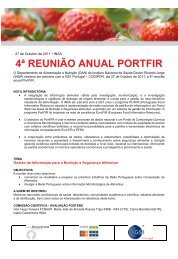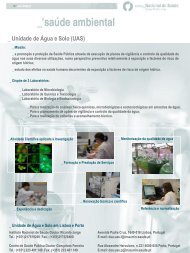European Society of Mycobacteriology - Instituto Nacional de Saúde ...
European Society of Mycobacteriology - Instituto Nacional de Saúde ...
European Society of Mycobacteriology - Instituto Nacional de Saúde ...
Create successful ePaper yourself
Turn your PDF publications into a flip-book with our unique Google optimized e-Paper software.
PP-18<br />
COMPARISON OF Mycobacterium BEIJING<br />
GENOTYPE WITH VNTR, SPOLIGOTYPING AND RFLP-IS6110<br />
Elahe Tajeddin , Parissa Farnia, Mohammad Kargar,Jamileh Noroozi, Mojtaba ahmadi,<br />
Mehdi kazempour, Maryam Hadadi,Mohammadreza Masjedi, Aliakbar Velayati<br />
<strong>Mycobacteriology</strong> Research Center (MRC) National Research Institute Of Tuberculosis and<br />
Lung Disease (NRITLD), Shahid Beheshti University Medical Campus.Tehran,Iran.<br />
Background<br />
Beijing strains constitute more than 1/4 <strong>of</strong> Mycobacterium tuberculosis (MTB) genotypes. Beijing genotype is consi<strong>de</strong>red<br />
an important genotype because <strong>of</strong> its reasonable characteristics such as: association with multi-drugs resistance TB.<br />
Accordingly these strains are reluctant to conventional TB drugs. Therefore, it is necessary to investigate the transmission<br />
rate among Beijing strains within the studied communities. In this study, three molecular methods (Spoligotyping, VNTR,<br />
and RFLP-IS6110) were used to i<strong>de</strong>ntify transmission among patients infected with Beijing strains.<br />
Materials and Methods<br />
The susceptibility tests were performed on 238 M. tuberculosis culture positive specimens. Thereafter, the isolated Beijing<br />
genotype was subjected to VNTR and RFLP. The results <strong>of</strong> Spoligotyping were analysed by using SPOLDB4 database.<br />
VNTR typing was used to i<strong>de</strong>ntify alleles diversity in 9 locus (MPTR-A, ETR-A, ETR-B, ETR-C, ETR-D, ETR-E, ETR-F,<br />
QUB11B, QUB3232) <strong>of</strong> isolated Beijing strains.The allelic diversity <strong>of</strong> VNTR was measured by using Hunter Gaston<br />
In<strong>de</strong>x (HGI).<br />
Results<br />
The spoligotyping <strong>of</strong> M. tuberculosis isolates revealed the following 8 patterns: Haarlem (27.7%), CAS1 (25.2%), EAI3<br />
(21.8%), CAS2 (6.7%), T1 (6.3%), Beijing(5.5%) U(5%), T(0.4), EAI2 (1.2%).<br />
The following VNTR loci (QUB3232), (QUB11b, ETR-E and ETR-F) and (other loci) were i<strong>de</strong>ntified as most (HGI≥ 0.6),<br />
median (HGI≥0.4-0.6) and weakest (HGI=0) distinctive loci for Beijing families respectively. Whereas the Beijing strains<br />
<strong>de</strong>monstrated diverse patterns in RFLP,13/13(100%) and VNTR 10/13(77%).<br />
Conclusions<br />
Beijing is one <strong>of</strong> the dominated circulating strains in Iran and interestingly majority <strong>of</strong> infected cases were due to reactivation<br />
rather than recent transmission.The VNTR and spoligotiping methods were more efficient to <strong>de</strong>tect Beijing strains<br />
than by use VNTR and RFLP allow.<br />
Keywords<br />
Spoligotyping / VNTR / RFLP / Mycobacterium tuberculosis Beijing genotype.<br />
90 ESM 2009



